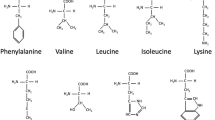Abstract
Frogs were injected for several weeks with β-guanidinopropionate, an isomer of creatine. Their sartorius muscles were isolated, poisoned with iodoacetate and stimulated isometrically with 75 shocks/min in nitrogen until rigor. In comparison with sartorius muscles of untreated frogs, they contained more free creatine and less phosphocreatine, but the same content in total creatine and ATP. They also contained β-guanidinopropionate both free and phosphorylated. However, muscles in rigor contained the same concentration of the phosphorylated form as resting muscles, i.e., phospho-β-guanidinopropionate was not split during contraction. The number of twitches performed before rigor was decreased. There was no change in the chemical energy usage (sum of phosphocreatine breakdown and twice ATP breakdown) per twitch.
Similar content being viewed by others
References
Aubert X (1956) Le couplage énergétique de la contraction musculaire. Ed. Arscia. Bruxelles, p 315
Aubert X, Marechal G, Deru M, Gillis JM (1957) Influence de l'intoxication iodacétique sur la fréquence de fusion tétanique et l'état d'activité du muscle strié. J Physiol (Paris) 49: 25–28
Bergström J, Fürst P, Noree LO, Vinnars E (1974) Intracellular free amino acid concentration in human muscle tissue. J Appl Physiol 36: 693–697
Canfield P, Marechal G (1973) Equilibrium of nucleotides in frog sartorius muscle during an isometric tetanus at 20° C. J Physiol 232: 453–466
Carlson FD, Siger A (1960) The mechanochemistry of muscular contraction. The isometric twitch. J Gen Physiol 44: 33–60
Carlson FD, Hardy D, Wilkie DR (1967) The relation between heat produced and phosphorylcreatine split during isometric contraction of frog's muscle. J Physiol 189: 209–235
Curtin NA, Woledge RC (1978) Energy changes and muscular contraction. Physiol Rev 58: 690–761
di Jeso F, Malcovati M, Gaetani MT, Speranza ML (1967) The identification and determination of phosphagen in insects and their eggs. Comp Biochem Physiol 20: 607–618
di Jeso F (1968) Qualitative and quantitative thin-layer chromatography of guanidine derivatives and differenciation of phosphagens from other phosphoryl compounds. J Chromatogr 32: 269–277
Ennor AH, Morrison JF (1958) Biochemistry of the phosphagens and related guanidines. Physiol Rev 38: 631–674
Ennor AH, Stoken LA (1948) The estimation of creatine. Biochem J 42: 557–563
Fitch CD, Jellinek M, Mueller EJ (1974) Experimental depletion of creatine and phosphocreatine from skeletal muscle. J Biol Chem 249; 4: 1060–1063
Fitch CD, Jellinek M, Fitts RH, Baldwin KM, Holloszy JO (1975) Phosphorylated β-guanidinopropionate as a substitute for phosphocreatine in rat muscle. Am J Physiol 228: 1123–1125
Hill AV (1952) A discussion on the thermodynamics of elasticity in resting striated muscle. Proc R Soc Lond [Biol] 139: 464–497
Hill AV (1965) Trails and trials in physiology, Edward Arnold, London, pp 374
Jaworek D, Gruber W, Bergmeyer HU (1970) In: Bergmeyer HU (ed) Methoden der enzymatischen Analyse II. Verlag Chemie, Weinheim, pp 2020–2024
Lohmann K (1934) Über die enzymatische Aufspaltung der Kreatinphosphorsäure; zugleich ein Beitrag zum Chemismus der Muskelkontraktion. Biochem Z 271: 264–277
Lundsgaard E (1930) Untersuchungen über Muskelkontraktionen ohne Milchsäurebildung. Biochem Z 217: 162–177
Marechal G (1964) Le métabolisme de la phosphocreatine et de l'adénosine triphosphate durant la contraction musculaire. Ed Arscia, Bruxelles, pp 184
Mommaerts WFHM (1969) Energetics of muscular contraction. Physiol Rev 40: 427–508
Mommaerts WFHM, Schilling MO (1955) Interruption of muscular contraction by rapid cooling. Am J Physiol 182: 579–584
Perry TL, Hansen S, Tischler B, Bunting R, Berry K (1967) Carnosinemia. A new metabolic disorder associated with neurologic disease and mental defect. N Engl J Med 277: 1219–1227
Rosenberg H, Ennor AH, Morrison JF (1956) The estimation of arginine. Biochem J 63: 153–159
Rowley GL, Greenleaf AL, Kenyon GL (1971) On the specificity of creatinekinase. New glycocyamines and glycocyamine analogs related to creatine. J Am Chem Soc 97: 5542–5551
Thoaï NV, Roche J (1964) Diversity of phosphagens. In: Leone CA (ed) Taxonomic biochemistry and serology. Ronald Press, New York, p 347–362
Author information
Authors and Affiliations
Rights and permissions
About this article
Cite this article
De Saedeleer, M., Marechal, G. Chemical energy usage during isometric twitches of frog sartorius muscle intoxicated with an isomer of creatine,β-guanidinopropionate. Pflugers Arch. 402, 185–189 (1984). https://doi.org/10.1007/BF00583333
Received:
Accepted:
Issue Date:
DOI: https://doi.org/10.1007/BF00583333




